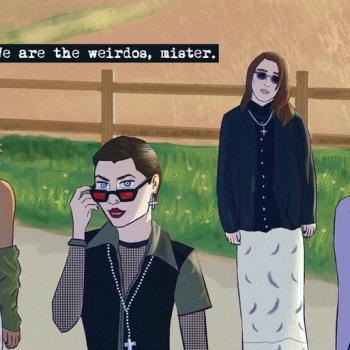
Source: Flickr user A. Davey
License
The Everlasting Gobstopper haunts me. Not because It fills children with blueberry juice, not because it has killed and may kill again. Rather, I wonder what happens if you don’t like one of the flavors. Presumably, if it covers everything from grape to pineapple and orange to strawberry, the treat will become a trick. I, for instance, hate artificial banana flavor. The thought of it washing away a nice cherry or lemon taste plagues me. Imagine the anticipation: every flavor you enjoy portends a flavor you hate. Each slow shift could lurch you over the edge. Maybe the gobstopper was just another of Mr. Wonka’s dastardly tricks.
Yesterday as I scarfed down my popcorn and tried to ignore the teens with their flashlights on a few seats down in the theater, I felt the same discomfort. On the screen: Oz Perkin’s new Nicolas Cage vehicle, Longlegs (2024). In 101 minutes, Longlegs snatches a veritable bevy of tropes from the horror grab bag and chucks them at the viewer like a pitcher with nothing to lose. I kept a tally as the minutes ticked by (and the teens down the row started taking pictures with the flash on—I think?): we got hicks, dolls, gender-bending villains (check out the Lou Reed poster above the killer’s vanity), Satanists, Catholicism, psychic powers, mental patients, and voodoo (or something like it). Kind to the end, Perkins also offers competent but serious Black police superior—not a horror trope but another from the genre soup.
Were these all egregious? By no means. Nicolas Cage’s character is wonderfully realized and eerie. His quick snaps and nonsense dialogue, which of course turns out not to be not so nonsensical, reinforce the overwhelmingly suspenseful mood. I wish more contemporary horror films opted for Longlegs‘ simmering approach. Long sequences shot only by flashlight make even innocuous lines of dialogue terrifying. I jolted once or twice from a simple “hey.”
But this suffocating atmosphere is never really released. Perkins deftly builds suspense to let the balloon squeak and fart its way to lifelessness. The rapid movement between tropes doesn’t help. It all begins to feel a little ridiculous when the Tiny Tim killer hails Satan, builds evil dolls, and manipulates hillbillies. Inevitably, such exercises feel more like checklists than fully developed narratives. It almost seems like an AI, paint-by-numbers approach to shocks and thrills.
None of that, however, means that Longlegs isn’t worth seeing (just don’t sit near those teens. God, I feel old, old as the sand in the desert—ever new but still old). It portends, I hope, good things for horror in the coming years. Eggers’ Nosferatu (2024) is due out this Christmas. Longlegs ought to tide us over until then.

















